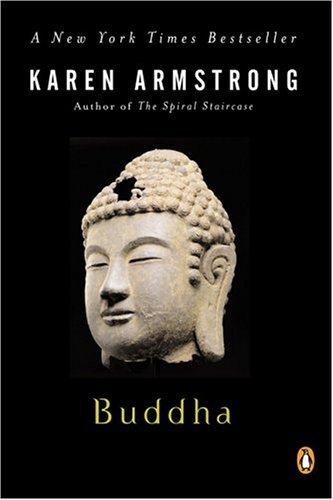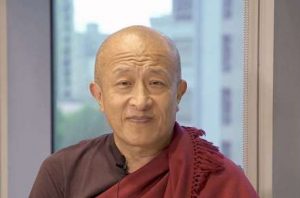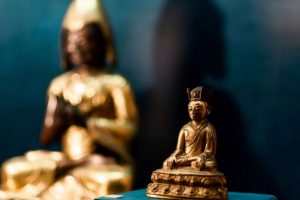This review was originally published in the 3rd issue (April 2007) of retired Bodhi Journal. Dr. Lisa Kemmerer is a philosopher-activist dedicated to working against oppression, whether on behalf of the environment, nonhuman animals, or disempowered human beings. Her books include In Search of Consistency: Ethics and Animals; Animals and World Religions; Sister Species: Women, Animals, and Social Justice; Call to Compassion: Reflections on Animal Advocacy; Speaking Up for Animals: An Anthology of Women’s Voices; and Primate People: Saving Nonhuman Primates through Education, Advocacy, and Sanctuary. Kemmerer has hiked, biked, kayaked, backpacked, and traveled widely, and is currently associate professor of philosophy and religions at Montana State University Billings.
Armstrong’s book, Buddha, is built around key events in the Buddha’s life: going forth, life as an ascetic, miraculous childhood events, the growth of the Sangha, and the end of his life on earth. Through these key events Armstrong offers readers the basics of Buddhist philosophy. Her book is of great interest, but is not without flaws.
Karen Armstrong is a popular writer for good reason – her writing is readable and she understands what appeals to her readers. However, Armstrong is not a scholar of religions; she holds a degree in English literature from Oxford. She notes in, The Spiral Staircase, “In theology, I am entirely self-taught” (287). Armstrong is thorough in her research, and explores religions systematically before putting pen to paper. Nonetheless, she is not a religious scholar or a Buddhist, let alone a Buddhist scholar. Buddhais easy to be read, and is sure to be read by many. For this reason, the strengths and weaknesses of Armstrong’s book on the life of the Buddha warrant special attention.
Sometimes Armstrong wanders off topic in Buddha. Early on, she provides information on world religions that is peripheral to the Buddha’s life and irrelevant to Buddhist philosophy. For example, she discusses the Axial Age, wandering from Zoroastrian faith to that of Socrates, from the prophets of Israel to Confucius. Sometimes her understanding of these diverse religious traditions appears minimal. For example, Armstrong leads readers to believe that Buddhism offered the people of India a completely new and improved religion. Buddha leads readers to believe that Buddhism is not in debt to earlier Indian traditions.
Armstrong introduces readers to dukkha, dhamma, and cakkavatti, using Pali terms liberally. For non-scholars, her use of Pali may lend credence to the common claim that she is a “renowned religious scholar” (as the back of this book states), but her plethora of foreign terms makes Armstrong’s otherwise simple read somewhat tiresome and difficult for those unfamiliar with Buddhist terms in an otherwise straight-forward book.
The more serious difficulties in Buddha are two-fold. First, Armstrong fails to commit to either a Mahayana or a Theravada point of view. Consequently, readers experience Gotama Buddha both as a man who gained extremely important spiritual knowledge through persistence and diligence, and also as one of many god-like Buddhas. In some passages the Buddha is portrayed as a mere man—though an exceptional man—on a spiritual quest, while in other passages the Buddha becomes a much more fantastic being, as when Armstrong notes that the Buddha gained enlightenment on the very spot where “all the previous Buddhas had positioned themselves” (89).
Perhaps even more disturbing, Armstrong’s voice is inconsistent; one never knows which cap she might be wearing. She travels randomly from an insider’s faith-perspective to a scholar’s scepticism and then to an outside observer’s reaction. For instance, Armstrong explains the miracle associated with the young Gotama at the ploughing ceremony (when the shade of a tree does not leave him as the day passes on), and she expresses doubt that such an event could have occurred, noting that such accounts “are certainly fictional” (67-8). Yet, later in the book, when a group of haughty men fail to pay homage to the Buddha, Armstrong frankly reports that “the Buddha staged a striking display of iddhi. He levitated, jets of fire and water gushed from his limbs, and finally he walked along a jewelled causeway in the sky” (132). She does not suggest that this incident might be fictitious.
In yet other portions of the book, Armstrong wears a cap of discerning scholarship, dispensing with both the insider’s perspective and the outside observer’s reaction. For example, she rightly notes that the mass conversions of Brahmins “should probably be read as a parable, depicting the early Buddhist’s confrontation with the old Vedic religion” (124). Yet, when similar evidence of rivalry emerges in other portions of the book, Armstrong fails to discern this same historic rivalry. At one point in the narration, she notes that the Buddha first attempted to teach the Dhamma to the Upaka, a Jain. She does not indicate the possibility of sectarian bickering at this point in the narrative, but provides a less-than-glamorous Buddhist account: The Jain responds to the Buddha, “Dream on, friend,” then flees from the Buddha’s presence, “refusing the direct route to Nibbana” (98).
But Armstrong’s book is not without merit. Her distance from the rigors of Buddhist scholarship is in some ways a benefit. Because the Buddha lived long ago, it is difficult to pin down facts with regard to the life and teachings of the Buddha. No one knows exactly what this famous man taught. No one knows for sure how he lived, where he travelled, or what he looked like. Armstrong boldly places thoughts in the Buddha’s head, words in the Buddha’s mouth, and actions behind the mysterious man we have come to know as Buddha. When notes are missing, Armstrong fills in the score. In this sense she offers what scholars cannot – a fuller picture of the possible life and lessons of the Buddha.
A fuller vision of the Buddha’s life has proven immensely attractive to many uncritical Western readers. Given Armstrong’s reputation as a writer and her popular title, “religious scholar,” Buddha will continue to reach many readers.
Armstrong’s work informs readers of some of the basics of the Buddha’s life and teachings in a lively and readable style (aside from the excessive Pali). She sometimes distorts historic information (such as Buddhism’s indebtedness to the Hindu tradition), and confuses basic details (such as the distinction between the Mahayana and Theravada traditions), but Armstrong is a skilled and bold writer, a writer willing to give creative voice where scholars and historians fall silent. Her book provides a contemporary, readable biography of the founder of a great religious tradition that continues to hold considerable interest in the West. For many readers interested in the basics of Buddhism and in the Buddha’s life, her book will be a likely selection.













